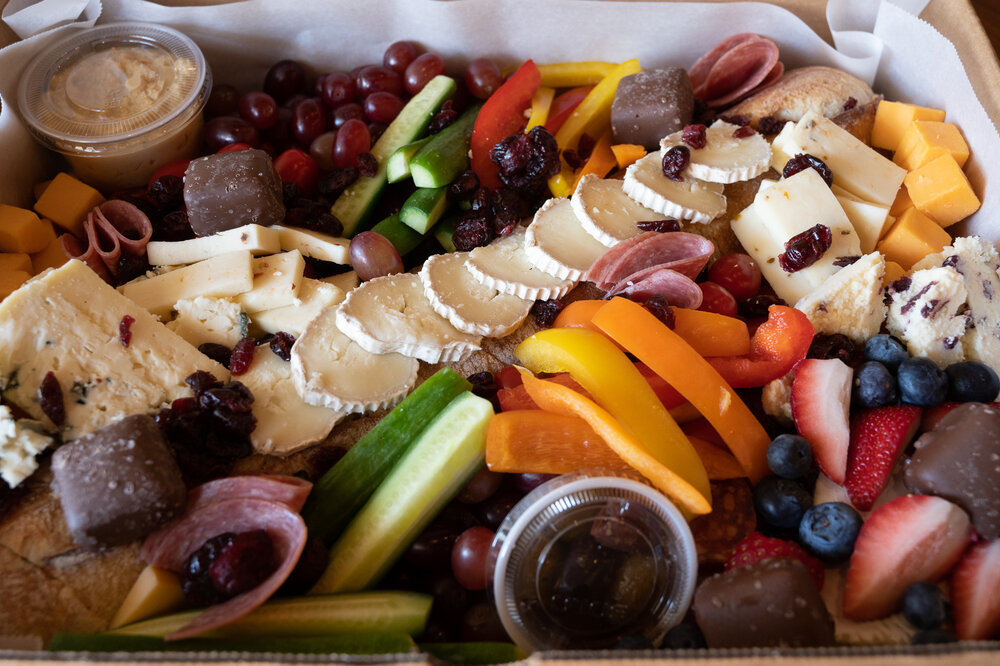Create Craveable Cheese Boards
March 11, 2021
By Kelly Visser, Iowa Food & Family Project
Cheese boards are a delicious way to express your creativity, experiment with flavor pairings and enjoy a memorable mealtime experience.

No matter if it is an impromptu snack or elaborate centerpiece, cheese boards deliver a tasty and memorable mealtime experience. The trendy tradition is a fun way to express your creativity, experiment with flavor pairings and expand your palate.
While there is no right or wrong way to create a cheeseboard, Midwest Dairy offers five tips to create a craveable combination:
1. Find the right board. A large wooden or slate board add contrast to the color of cheeses.
2. Select the cheeses. Follow the rule of odds. Plan on three to five cheeses depending upon how many people will be enjoying the board. Choose a variety of flavors and textures. Typical serving size for cheese is 1-2 ounces per person per variety.
3. Pick the meats. To provide more variety and flavor, include a selection of cured meats, such as coppa, speck, prosciutto or salami.
4. Incorporate sides galore. Add color, texture and a variety of flavors. You can’t go wrong with fresh or dried fruits, nuts and bread. Surprising items like honey, mustard, jams and pickled vegetables are also great options.
It is best to store cheese in a two-ply paper which allows it to breathe while maintaining optimal humidity. If you don’t have cheese paper, wrap in waxed or parchment paper then in plastic wrap.
To bring out the best flavors in cheese, remove it from the refrigerator at least a half hour before serving.
Categories of Cheeses
Consider selecting from a variety of textures and flavors across these four categories of cheese.
- Fresh Cheeses: These cheeses are high in moisture and smooth on the palate. They are mild, rich and creamy and ideal for spreading. This category includes marscapone, havarti, feta and queso fresco.
- Soft-Ripened: Soft, ripened cheeses have a bloomy, edible rind that ripens the cheese from the outside in. Be sure to bring these varieties to room temperature before serving. You can warm in the oven or serve in a puff pastry crust. This category includes brie and Camembert.
- Blue-Veined: These cheeses feature a blue-to-grey streaking, a distinctive taste and a pleasant pique on the palate. This category includes Stilton, Gorgonzola and blue.
- Hard and Semi-Hard: Hard cheeses deliver a flavor intensity that is beyond compare, while semi-hard cheeses have a firm texture with a variety of flavors. This category includes cheddar, Gouda, Swiss and Parmesan cheeses.
Good Cheese Starts on the Farm
Good cheese starts on the farm. Iowa is home to more than 1,300 dairy farms, which are dedicated to animal care and sustainability.
For multi-generational dairy farmers John and Joan Maxwell, sustainability means caring for their land to pass on to the next generation. The couple, along with their daughter Amy, own and operate Cinnamon Ridge Farms in Scott County. The farm is home to 220 Jersey dairy cows, innovative environmental practices and a creamery, where award-winning Cinnamon Ridge cheddar cheese is produced.
Please note, by clicking the following links, you’ll be leaving a partially funded checkoff site.
Cinnamon Ridge Farms is just one example of a modern dairy farm that is committed to sustainability.
The Innovation Center for U.S. Dairy recently set an environmental stewardship goal for the dairy industry to achieve carbon neutrality, optimize water usage and maximize recycling, and manage manure and nutrients to improve water quality by 2050.
U.S. dairy has always been committed to nourishing people, communities and the planet to foster a sustainable future.
Over the past decade, the industry reduced the carbon footprint of each gallon of milk by 19%, using 30% less water and 21% less land. These achievements have been made possible by advances in cow care, nutrition, genetics and technology. From 1960 to today, milk production in the U.S. has nearly doubled despite fewer cows.